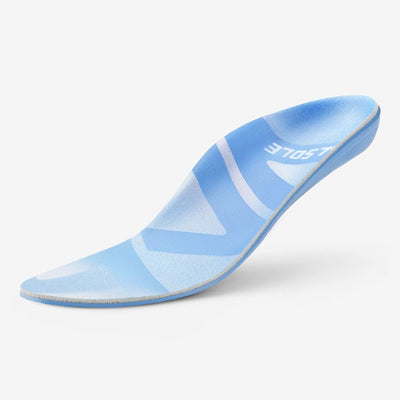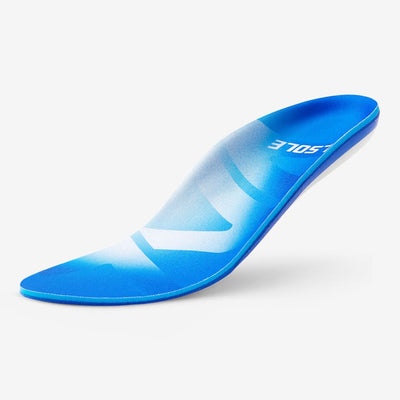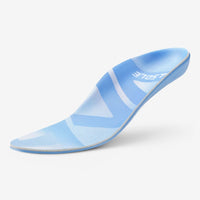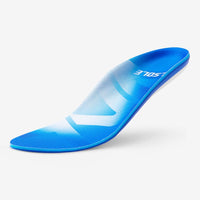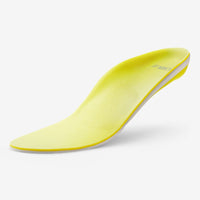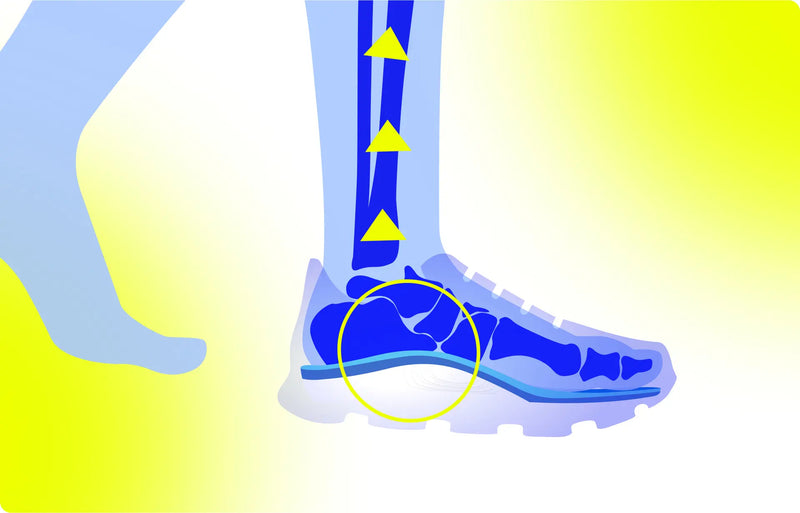How Foot Health Contributes to Joint Pain

When it comes to joint pain, the knees, hips, and back often steal the spotlight. However, the root cause of these problems frequently lies much lower: in your feet. Poor foot health, whether due to misalignment, lack of support, or overuse, can set off a chain reaction of problems throughout the body. Joint pain stemming from foot issues is not uncommon, especially for weightlifters and those who spend hours standing. By understanding the biomechanical relationship between foot health and joint function, individuals can take proactive measures to protect their joints while maintaining optimal performance.
The Overlooked Connection Between Foot Health and Joints
Joint pain is often a downstream effect of poor foot mechanics. The knees and hips, in particular, are highly susceptible because of their role in absorbing and transferring forces during movement. When the feet are misaligned or lack proper support, they disrupt the natural mechanics of these joints, leading to pain, inflammation, and long-term damage.
1. Knee Pain and Foot Mechanics
The knee is a hinge joint designed to facilitate flexion and extension while bearing significant loads. However, its function depends heavily on proper alignment, which begins at the feet. When foot mechanics are compromised, abnormal stress is placed on the knee, often exacerbating or causing conditions such as:
-
Patellofemoral Pain Syndrome (Runner’s Knee): Poor foot alignment, especially overpronation, forces the kneecap (patella) to track incorrectly in its groove. This misalignment increases friction and strain on the cartilage behind the patella, resulting in anterior knee pain (Tateuchi et al., 2021).
-
Knee Valgus (Knock-Knees): Collapsed arches cause the knees to angle inward unnaturally. This condition amplifies stress on the medial (inner) knee structures, including the medial meniscus and medial collateral ligament (MCL), increasing the risk of sprains, tears, and degenerative changes (Levinger & Gilleard, 2019).
-
Osteoarthritis: Chronic misalignment can lead to uneven wear on the knee’s cartilage, accelerating joint degeneration. For instance, individuals with flat feet often develop arthritis on the inner knee compartment due to persistent overloading (Nigg et al., 2020).
2. Hip Pain and the Role of Foot Alignment
The hip is a ball-and-socket joint that supports the trunk and facilitates multidirectional movement. Like the knees, the hips depend on a stable foundation from the feet to function optimally. When foot health is compromised, the resulting misalignment can lead to hip-specific issues such as:
-
Hip Impingement: Abnormal foot mechanics, such as overpronation or supination, can tilt the pelvis, altering the alignment of the femoral head in the hip socket. This misalignment increases the risk of impingement, where bones rub abnormally against one another, causing pain and restricted range of motion (Tateuchi et al., 2021).
-
Hip Bursitis: Poor foot support can contribute to uneven loading in the hip joint, causing inflammation of the bursa (fluid-filled sacs) that cushion the joint. This is particularly common in individuals who stand or walk for extended periods without proper arch support (Levinger & Gilleard, 2019).
-
Labral Tears: Chronic misalignment may also place excess strain on the hip labrum, a ring of cartilage that stabilizes the joint, leading to tears and long-term instability (Nigg et al., 2020).
3. Compounding Effects on the Kinetic Chain
Beyond isolated pain in the knees or hips, poor foot health creates a cascading effect along the entire kinetic chain, amplifying joint stress and dysfunction. For example:
-
Uneven Pressure Distribution: Misaligned feet lead to uneven force distribution during walking, running, or lifting. This imbalance causes one side of the body to bear more weight, increasing the likelihood of joint pain and injury (Tateuchi et al., 2021).
-
Rotational Strain: Abnormal foot positioning can cause rotational forces to travel up the leg, forcing the knee and hip joints to move in unnatural planes. Over time, this can lead to ligament tears, cartilage damage, and joint instability (Levinger & Gilleard, 2019).
-
Compensatory Movements: When foot problems persist, the body compensates with altered movement patterns, placing unnatural stress on surrounding joints. For instance, someone with flat feet may unconsciously change their stride to reduce foot discomfort, only to develop pain in their knees or hips instead (Nigg et al., 2020).
4. Long-Term Joint Degeneration
The cumulative effect of poor foot health on the joints cannot be overstated. Over time, the constant misalignment and uneven loading caused by issues like flat feet, high arches, or insufficient cushioning lead to degenerative joint diseases such as:
-
Cartilage Erosion: Misaligned feet increase joint friction, which wears away protective cartilage, leading to conditions like knee osteoarthritis or hip osteoarthritis (Levinger & Gilleard, 2019).
-
Bone Spurs: Chronic joint stress can trigger the development of bone spurs in the knees or hips, further reducing mobility and increasing pain (Tateuchi et al., 2021).
-
Chronic Inflammation: Repeated strain on the knees and hips often results in persistent inflammation, contributing to conditions like tendinitis or synovitis (inflammation of the joint lining) (Nigg et al., 2020).
Why Certain Groups are Particularly Affected?
Although anyone can experience joint pain linked to foot health, certain groups are more vulnerable. Weightlifters and people who spend long hours standing are particularly at risk due to the unique demands they place on their feet and joints.
1. Workers on Their Feet All Day
Standing for extended periods places continuous pressure on the feet, which can lead to fatigue, swelling, and pain. Over time, this stress can contribute to joint problems in the knees and hips. People who work in jobs requiring long hours on their feet—such as healthcare professionals, retail workers, and factory laborers—are particularly prone to these issues.
Without proper support, prolonged standing can exacerbate foot conditions like plantar fasciitis or bunions. These issues, in turn, alter gait patterns, causing compensatory stress on the knees and hips.
2. Weightlifters
Weightlifters rely heavily on their feet to provide stability and support during heavy lifts. Exercises like squats and deadlifts require a solid foundation to generate power and maintain balance. Any misalignment in the feet can compromise form, increase stress on the knees, and reduce overall performance. Additionally, the repetitive nature of lifting creates wear and tear on the joints, amplifying the effects of poor foot mechanics.
Improper foot support during lifting can also lead to injuries. For example, a lifter with flat feet may experience knee pain due to increased inward rotation of the lower leg. Over time, this can progress to chronic conditions such as patellofemoral pain syndrome (Nigg et al., 2020).
Actionable Tips for Maintaining Joint Health
The good news is that there are practical steps you can take to protect your joints and improve foot health. Incorporating these strategies into your routine can help reduce pain, enhance performance, and prevent long-term damage.
1. Prioritize Supportive Insoles
Using high-quality insoles, such as VALSOLE, is one of the simplest yet most effective ways to address foot-related joint pain. Designed with features like anatomically correct arch support and shock absorption, VALSOLE insoles help:
-
Promote Proper Alignment: By maintaining a neutral foot position, they reduce stress on the knees and hips.
-
Enhance Stability: Improved balance ensures better form during heavy lifts or prolonged standing.
-
Absorb Impact: Shock-absorbing materials reduce joint strain, making daily activities and workouts more comfortable.
For weightlifters, VALSOLE insoles provide the stable foundation needed for optimal performance. For workers, they offer all-day comfort and protection against fatigue.
2. Strengthen Supporting Muscles
Strong muscles act as natural shock absorbers, protecting your joints from excessive strain. Incorporate these exercises into your routine:
-
Calf Raises: Strengthen the lower legs to support the feet and ankles. Perform 3 sets of 15–20 repetitions.
-
Glute Bridges and Hip Thrusts: Build hip stability to reduce stress on the knees and lower back.
-
Core Workouts: A strong core ensures better posture and alignment, reducing compensatory stress on the lower body.
-
Ankle Mobility Drills: Exercises like ankle circles and dorsiflexion stretches improve mobility, reducing the risk of injury.
3. Wear Proper Footwear
Footwear is just as important as insoles when it comes to joint health. Weightlifters should opt for shoes with a firm, flat base to provide the stability needed for heavy lifts. Workers should look for cushioned shoes with good arch support to alleviate pressure during long shifts. Replace shoes regularly, as worn-out soles lose their ability to provide adequate support (Nigg et al., 2020).
4. Focus on Recovery
Recovery is essential for maintaining joint and foot health, especially for those who place heavy demands on their lower body. Incorporate these practices:
-
Stretching: Regularly stretch the calves, hamstrings, and Achilles tendon to relieve tension and improve flexibility.
-
Foam Rolling: Use a foam roller to release tightness in the feet, calves, and thighs.
-
Elevate Your Feet: After standing or lifting for long periods, elevate your feet to reduce swelling and improve circulation.
5. Maintain Proper Lifting Form
For weightlifters, maintaining proper form is crucial for avoiding joint injuries. Key tips include:
-
Keep your knees aligned with your toes during squats to avoid inward collapse.
-
Engage your core to stabilize your spine and maintain a neutral posture.
-
Avoid overloading weight beyond your capacity, which can compromise form and increase injury risk.
If you’re unsure about your form, work with a coach or trainer to ensure proper technique.
Assessing the Problem from the Root
Regular foot assessments are essential for anyone who relies heavily on their feet, whether for work or fitness. A podiatrist or physical therapist can identify issues like flat feet, overpronation, or plantar fasciitis early and recommend appropriate interventions.
Addressing foot health proactively can significantly reduce joint strain and improve overall mobility, safeguarding joints from unnecessary wear and tear. Complementing this with using supportive insoles, strengthening exercises for stabilizing muscles, wearing footwear designed for your activity, and giving your body time to recover are essential strategies for long-term joint protection.
Joint health depends on small, consistent actions that start at the feet. Regular foot assessments and a focus on proper biomechanics can help you prevent injuries, maintain an active lifestyle, and continue to move freely without pain. Prioritize your feet, and your joints will thank you for years to come.
References
Levinger, P., & Gilleard, W. (2019). Biomechanics and lower limb joint health: Implications for physical activity. Journal of Orthopedic Research, 37(8), 1824–1833. https://doi.org/10.1002/jor.24313
Nigg, B. M., Baltich, J., Hoerzer, S., & Enders, H. (2020). Biomechanical considerations on footwear and insoles. Journal of Biomechanics, 102, 109707. https://doi.org/10.1016/j.jbiomech.2020.109707
Tateuchi, H., Taniguchi, M., & Fukumoto, K. (2021). The effect of foot alignment on knee biomechanics during exercise. Physical Therapy in Sport, 50, 123–130. https://doi.org/10.1016/j.ptsp.2021.03.011

